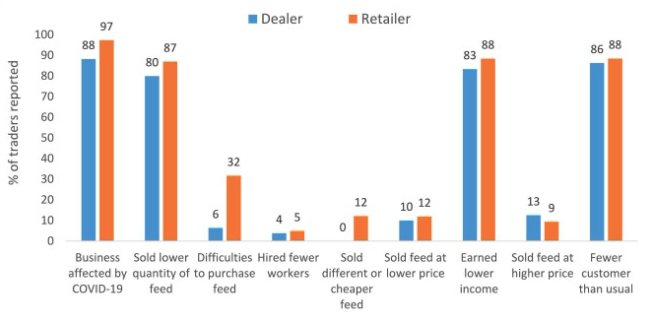
Authors: Hazrat Ali, Ben Belton, Mohammad Mahfujul Haque, and Khondker Murshed-e-Jahan
Abstract
The rapid growth of aquaculture in Bangladesh over the past three decades has been facilitated by increasing supplementary feed use and increasing numbers of feed suppliers, but little is known about the organization and behavior of the feed supply segment of the aquaculture value chain. We conducted a comprehensive survey with 79 feed suppliers of two types: ‘dealers’ linked to feed companies (n = 34) and independent retailers (n = 45), in the seven main aquaculture producing districts of southern Bangladesh in 2021 to address this knowledge gap. We found the following. (1) Over the past 10 years, the number of traders increased 70% and the volume of feed traded almost doubled. (2) Feed supply is shifting from traditional agricultural byproducts to formulated feeds (47% of total feed), and floating feeds as a subset of those (54% of formulated feed), contributing to increasing farm productivity. (3) The formulated fish feed market in Bangladesh is diverse but quite concentrated. Feed suppliers sold formulated feed produced by 35 companies, with eight companies accounting for 74% of sales. (4) Feed handling practices are efficient. Traders sell feeds quickly (average turnover time 10 days) and storage practices are adequate to maintain quality. (5) No traders reported experiencing any waste or loss of feed during their most recent completed transaction, and only 5% of traders reported losing a small portion of feed (1.7%) during transport. (6) The average profit margin earned by feed suppliers is a modest 6.2%. (7) Feed trading creates substantial employment: 43,937 full-time equivalent (FTE) jobs in the seven surveyed districts. In sum, the feed supply segment of the aquaculture value chain in southern Bangladesh is dynamic, well-developed, and relatively competitive and efficient. This finding is contrary to conventional wisdom, which often portrays the sector as inefficient and beset by problems.
Read the full publication at https://doi.org/10.1016/j.aquaculture.2023.739897.
Published July 28, 2023

